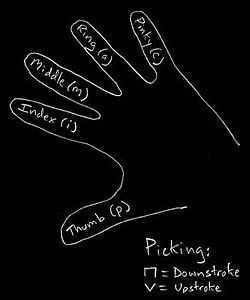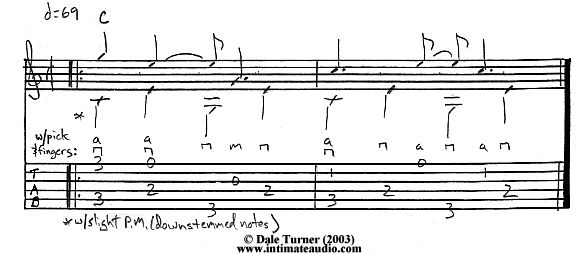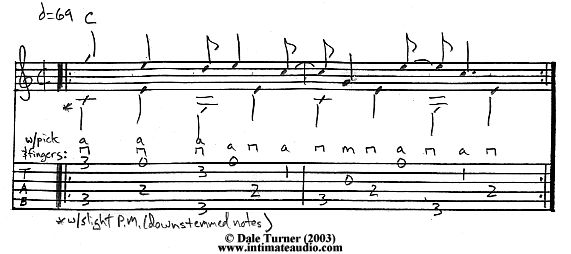For
many styles of music where acoustic guitar plays a prominent role,
busting out a bit o' Travis Picking—that is, using your
pickhand's fingers (or fingers + thumbpick, hybrid
picking,
etc.) to create a steady 1/4-note bass line (that alternates between
chord tones) and generate little melodies—might just be what
the doctor ordered, if your song merits something other than routine
chord strumming.
In
case you're curious, the plucking technique known as “Travis
Picking” is named in honor of the legendary Merle
Travis, credited as being the first to popularize the approach.
In addition to country, Travis Picking also worked its way into
the Rockabilly sounds of early Elvis recordings, courtesy of the
great Scotty Moore. In later years, everyone from Chet Atkins, Jerry
Reed, and Lenny Breau to acoustic crooners like James Taylor, Jim
Croce, Dan Fogelberg, John Denver, and Lindsey
Buckingham made big waves with this timeless approach. The technique
has also surfaced in a variety of folk music recordings!
Without
further ado, let's take a closer look at the mechanics involved
in this often perplexing style. Hopefully by lesson's end you'll
be on the road towards developing better rhythmic independence between
your bass and melodic parts, and walk away with some useful pluckin'
patterns! Let's git...
Before
we start, note that all of the examples presented
in this lesson are played (and notated accordingly) using pick-and-fingers
technique, a.k.a. hybrid picking—an approach that
combines elements of fingerstyle and pick-style techniques. In contrast
to traditional “classical” fingerstyle technique [where
the thumb (p) is usually responsible for plucking the bottom
three “wound” strings, while the index (i), middle
(m), and ring (a) fingers are reserved for strings
3-1, respectively], in “hybrid picking” the pick is viewed
as a replacement for the plucking hand's thumb, while the middle
(m), ring (a), and (sometimes) pinky (c) fingers
are used to pluck the higher strings.
In
a nutshell, throughout this lesson you'll be using the pick to play
all the bass notes on strings 4-6 (using downstrokes throughout),
while the pickhand's middle and ring fingers are used to pluck notes
on the E, B, and G strings. The
following graphic should help clarify the various “plucking
hand” terms and symbols you'll see in this lesson:

So
why hybrid picking? For starters, many steel-string acoustic stylists
use pick-and-fingers technique as an alternative approach for “traditional”
fingerstyle playing simply to minimize the risk of shredding their
fingernails (if they also play nylon-string, for instance). Further,
in the likely event the songs they play also contain standard strumming
moves, funky riffs, or lead lines, having the pick already in hand
provides more flexibility! Further, incorporating palm muting into
the world of fingerstyle guitar is a tricky task. That's part of
the reason authentic “Travis Pickers” often opt to use
a thumbpick. However, given that most folks are not accustomed to
using a thumbpick (let alone own one!), pick-and-fingers makes perfect
sense. 'Nuff said!
At
the foundation of any Travis Picking pattern lies a steady 1/4-note
bass line, largely derived from the root and fifth
of each chord being played. Given that the vast majority of exercises
and plucking patterns in this lesson will be applied to a basic,
open-position C chord (a chord containing the notes C-E-G), it makes
sense that we take a close look at a “C” chord's foundational
bass line right away!
Below
[Fig. 1A],
you'll see a “C(root)-G(fifth)” bass pattern with notes
sounding on beats “one” and “three.” To play
this properly, begin by fretting an open-position “C”
chord—where your fret hand's ring finger grabs the root (C)
on the 5th string (3rd fret). Next, in playing Fig. 1A, switch this
finger back and forth between the 5th and 6th strings, alternating
between the “C” and “G” (3rd fret, 6th string)
bass notes. Use
your pick to play these (downstrokes throughout), picking
them with slight palm muting for proper “Travis Picking”
effect. (NOTE: Keep in mind
that, for Travis Picking to sound “country”-like, palm
muting is key. For this plucking style to sound more “at home”
in genres like acoustic rock, folk, etc., simply refrain from palm
muting.) In Fig.
1B our introductory bass pattern is beefed up into a “C-E-G-E”
line, where a different chord tone is sounded on each beat. (Again,
grab each of the notes on the 5th and 6th strings by moving your
fret hand's ring finger back and forth.) With the exception of Fig.
13 (this lesson's final figure), all the examples in this
lesson will be built upon this bass line (Fig. 1B), so you'd be
best served to get this down till it feels automatic.
|
Adding
A Single Melody Note
|
If
one of your goals as a Travis Pickin' pupil is to be able to improvise
using this revered plucking style, you'll want to get comfortable
with as many different finger combinations (especially index and
ring finger combos on different strings) and rhythms as possible—all
the while keeping your bass line flowing flawlessly!
In
Fig. 2A
below, a single note (“C”) is added to our earlier bassline,
plucked on each individual beat (in synch with the bass line) using
the ring (a) finger. Meanwhile, Fig.
2B illustrates our new “C” note stated in half
notes (that is, sustained for two beats each). This requires a subtle
form of rhythmic independence between your picked bass notes (the
1/4 notes) and sustained melody notes (1/2 notes) because these
notes are not all plucked simultaneously (as in the previous
example). Basically, you don't want your picked bass notes
to (1.) drown out the pitches on your 2nd string, (2.) prevent them
from ringing, or (3.) force them to stop ringing. (NOTE:
From here on out, our bassline will appear in “downstemmed”
fashion, with melody notes written “upstemmed.” This is
a form of divisi notation—a notational style used to
clarify independent voices appearing on a single staff.)
|
Hemiola
Effect
(The Next Step Towards Rhythmic Independence)
|
By
engaging in a rhythmic effect referred to as hemiola—the
rhythmic relation of three against two (or four)—your plucking
hand fingers are forced to sound notes in a variety of combinations.
Similar to a polyrhythm, the hemiola effect in Fig.
3 results from maintaining our ever-present four-note
bass line, while plucking our “C” (1st fret, 2nd string)
every three 1/4-note beats. Again, you're pitting three against
four.
Meanwhile,
the hemiola effect employed in Fig.
4 results from
maintaining our familiar bass line while plucking our “C”
(1st fret, 2nd string) every three eighth-notes.
|
Adding
Another String to the Equation
|
With
this next handul of exercises we'll break in our plucking hand's
middle finger (m), using it to sound the open G string in
a variety of different rhythmic combinations. Fig.
5A alternates between our familiar “C” note on
beats “one” and “three,” squeezing in our new
“G” on beats “two” and “four.” The
roles of these two melody notes are reversed in Fig.
5B.
Now
let's up the rhythmic ante and unload some eighth notes! Fig.
6A and Fig.
6B expand upon the previous pair of examples by alternating
between our new “C” and “G” notes at a more
rapid rate—pluckin' at a pace of two evenly-spaced notes per
beat! Party!
|
Hemiola
Effect Using Two Treble Strings
(Another Step Towards Rhythmic Independence)
|
In
Fig. 7
below, our new set of notes are run through the ol' hemiola
ringer—akin to the earlier Fig. 4,
featuring treble strings plucked every three eighth notes over our
groovy bass line.
Finally!
If you've gotten this far, you've survived enough rhythmic nuttiness
to really start soaking up some useful Travis Picking patterns!
Keep in mind, all these “patterns” may also be adapted
to other open chord shapes (you just gotta make sure you're grabbing
the right chord tones for a functional bass line!)
Fig.
8A illustrates a tasty li'l pluckin' pattern, suitable for
everything from subtle acoustic rock, to foot stompin' country!
Fig.
8B
depicts a slight modification to the previous example, in that it
grabs a note on the high E string—that means we've just added
another note to our ever-evolving Travis pluckin' prowess!
Fig.
9A
is another useful Travis Picking pattern using our fun li'l open-position
C chord. Notice that, in this case, the majority of “melody”
notes occur on the upbeats (the “and” portion of each
beat).
In
line with the logic of Figs. 8A-B, Fig.
9B is a variation that incorporates the open 1st string,
providing us with three “melody” notes for your pluckin'
pleasure!
These
last two plucking patterns involving the almighty “C”
chord feature extra notes positioned along various strings, providing
more melodic options.
In
Fig. 10,
the fretting hand's pinky is used to grab a “G” note on
the high string (3rd fret). This particular note, which is a chord
tone (“G” is a C chord's “fifth”), provides
us with a wider range of arpeggio notes to draw from—different
C-E-G notes, spread to the upper reaches
of our axe (in open position).
 |
|
|
A
development of the previous figure, Fig.
11 takes our expanded C chord's range (again, featuring
a “G” on the high string) and adds a scale tone—the
note “D” (3rd fret, 2nd string)—into its equation.
(HINT:
Use your pinky for this note!) As you'll soon see, the more
comfortable you get with the basic mechanics of Travis Picking (passages
largely derived from notes in each chord's arpeggio), you'll fnd
it easier to start incorporating other scale tones into the picture.
For fun, experiment by weaving other notes from the C major scale
(C-D-E-F-G-A-B) into the framework of this type of plucking pattern.
[HINT: In this particular chord
shape, some of the more “grabbable” melody notes might
be F (1st fret, 1st string), D (3rd fret, 2nd string), and A
(2nd fret, 3rd string).]
 |
|
|
To
wrap up our “pluckin' patterns,” here's a pretty involved
passage used to outline a C7 chord [Fig.
12]. This chord, which adds a “b7” (the note “Bb,”
courtesy of your fret-hand's
pinky) to our basic C chord, is sonically more suited
for country and blues. However, some famous classic rock songs—like
the tasty Harry Nilsson nugget, “Coconut” (some of you
may know this track as the closing cut in the film Reservoir
Dogs)—revolve around this sound almost exclusively.
In
addition to using notes straight out of a C7 chord's arpeggio (C-E-G-Bb),
the example below adds melody notes like F (1st fret, 1st string;
fretted w/index finger) and D (3rd fret, 2nd string; fretted w/pinky)
to the equation. Note the “pull-off” on the second string
in the final measure (beat “four”).
|
In
the Style of Fleetwood Mac's “Landslide”
|
For
fun, I reckon I'll close out this monster Travis Picking lesson
with a little passage [Fig.
13] I created as a “solo interlude” for use in
the classic Fleetwood Mac song, “Landslide.” (The tune's
normally played with a capo at the 3rd or 5th fret... I forget!).
This li'l arrangement features mucho melodicism along the upper
strings (particularly the 2nd string), phrased with various hammer-ons/pull-offs
for maximum ear-pleasing effect. Enjoy!
|
Like
This 100% Free Acoustic Guitar Lesson?
|
To
help support this site's free online guitar lessons, please check
out my brand-new “full band” album of original compositions,
MANNERISMS
MAGNIFIED (now available through
CDBABY.com,
iTunes
and AMAZON.COM),
featuring me performing all the instruments (voices, guitar, bass,
real acoustic drums, piano, accordion, and mandolin). I also produced,
arranged, engineered, and did all the artwork/illustrations—intimate
audio AND visual, lol! (Details can be seen in my YouTube:
ALBUM PREVIEW/documentary.)
I’d love to hear your thoughts! Thank you :)
|
For
More Travis Picking...
|
If
you're hankerin' for more Travis Picking, there is a pretty massive
amount of Travis Picking patterns in a book I did called THE
GUITARIST'S SURVIVAL KIT (pages 13-15). Tons of open-position
ones, for virtually every “normal” chord, as well as a
big section on fully-fretted, moveable versions (tricky!). The level
of difficulty ranges from intermediate to pretty darned advanced.
There are 11 totally unique chord patterns in all, each at least
two bars long! Hope you like...
 |
The
Guitarist's Survival Kit Written
by Dale Turner. For guitar. Includes instructional book and
examples cd. With introductory text, instructional text, musical
examples (tab and standard notation) and guitar chord diagrams.
Instructional. 48 pages. 9x12 inches. Published by Hal Leonard.
(HL.695380)
See
more info... |
 |
Merle
Travis-Sixteen Tons Rare Performances
1946-1981, Vol. 2. by Merle Travis. For Guitar (Fingerpicking).
concert/documentary. Vestapol. Country. Level: Intermediate.
Video. Size 4.13x7.5. Duration 60 minutes. Published by Grossman's
Guitar Workshop. (95901VX)
See
more info... |
 |
Merle
Travis Guitar Style by Merle Travis
and Tommy Flint. For Guitar (Fingerpicking). method. Non-Series.
Country. Level: Beginning-Intermediate. Book/CD Set. Size 8.75x11.75.
176 pages. Published by Mel Bay Publications, Inc. (93344BCD)
See
more info... |
 |
The
Merle Travis Collection Performed
by Merle Travis. Guitar Recorded Versions (Authentic note-for-note
transcriptions). With notes and tablature. Size 9x12 inches.
96 pages. Published by Hal Leonard. (690233)
See
more info... |

